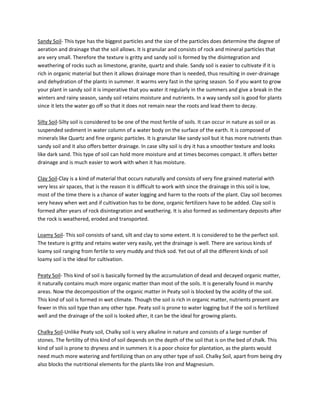
Sandy soil
- 1. Sandy Soil- This type has the biggest particles and the size of the particles does determine the degree of aeration and drainage that the soil allows. It is granular and consists of rock and mineral particles that are very small. Therefore the texture is gritty and sandy soil is formed by the disintegration and weathering of rocks such as limestone, granite, quartz and shale. Sandy soil is easier to cultivate if it is rich in organic material but then it allows drainage more than is needed, thus resulting in over-drainage and dehydration of the plants in summer. It warms very fast in the spring season. So if you want to grow your plant in sandy soil it is imperative that you water it regularly in the summers and give a break in the winters and rainy season, sandy soil retains moisture and nutrients. In a way sandy soil is good for plants since it lets the water go off so that it does not remain near the roots and lead them to decay. Silty Soil-Silty soil is considered to be one of the most fertile of soils. It can occur in nature as soil or as suspended sediment in water column of a water body on the surface of the earth. It is composed of minerals like Quartz and fine organic particles. It is granular like sandy soil but it has more nutrients than sandy soil and it also offers better drainage. In case silty soil is dry it has a smoother texture and looks like dark sand. This type of soil can hold more moisture and at times becomes compact. It offers better drainage and is much easier to work with when it has moisture. Clay Soil-Clay is a kind of material that occurs naturally and consists of very fine grained material with very less air spaces, that is the reason it is difficult to work with since the drainage in this soil is low, most of the time there is a chance of water logging and harm to the roots of the plant. Clay soil becomes very heavy when wet and if cultivation has to be done, organic fertilizers have to be added. Clay soil is formed after years of rock disintegration and weathering. It is also formed as sedimentary deposits after the rock is weathered, eroded and transported. Loamy Soil- This soil consists of sand, silt and clay to some extent. It is considered to be the perfect soil. The texture is gritty and retains water very easily, yet the drainage is well. There are various kinds of loamy soil ranging from fertile to very muddy and thick sod. Yet out of all the different kinds of soil loamy soil is the ideal for cultivation.Peaty Soil- This kind of soil is basically formed by the accumulation of dead and decayed organic matter, it naturally contains much more organic matter than most of the soils. It is generally found in marshy areas. Now the decomposition of the organic matter in Peaty soil is blocked by the acidity of the soil. This kind of soil is formed in wet climate. Though the soil is rich in organic matter, nutrients present are fewer in this soil type than any other type. Peaty soil is prone to water logging but if the soil is fertilized well and the drainage of the soil is looked after, it can be the ideal for growing plants.Chalky Soil-Unlike Peaty soil, Chalky soil is very alkaline in nature and consists of a large number of stones. The fertility of this kind of soil depends on the depth of the soil that is on the bed of chalk. This kind of soil is prone to dryness and in summers it is a poor choice for plantation, as the plants would need much more watering and fertilizing than on any other type of soil. Chalky Soil, apart from being dry also blocks the nutritional elements for the plants like Iron and Magnesium.<br />
